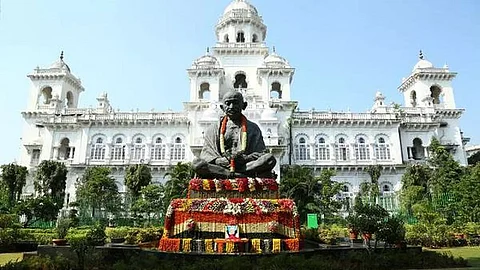

Telangana Legislative Assembly is set to expand to 153 members (present 119 Assembly segments) following the upcoming national census. By the next elections, there is a plan to include 50 female representatives, in line with the 33% Women's Reservation. The state will see the creation of 34 new assembly constituencies. Once the national census concludes by March 2027, a delimitation commission will begin its work, which is expected to be completed within six months. Consequently, the Telangana Legislative Assembly elections, scheduled for November-December 2028, are anticipated to take place under this new constituency framework. Notably, a 33% reservation for women will be implemented starting with this election. The establishment of new constituencies will also entail adjustments to the geographical boundaries of certain existing ones, signalling significant political changes within the state. Delimitation efforts will be based on an average population figure derived from the latest demographic data.
Telangana Challenge Population-Based Delimitation
The Telangana Legislative Assembly has recently adopted a resolution calling on the Union government to amend the Constitution to raise its assembly seats from 119 to 153. This request is by the Andhra Pradesh Reorganisation Act of 2014, which allows for an increase in assembly seats for both Telangana (119 to 153 seats) and Andhra Pradesh (175 to 225 seats). At the center of this dialogue is the upcoming delimitation exercise, which is set to take place after the first census conducted post-2026. Currently, the allocation of assembly seats is based on data from the 1971 census, a measure intended to promote population control. However, southern states, including Telangana, are expressing concerns over a delimitation process that relies exclusively on contemporary population figures. They argue this approach could disadvantage states with effective family planning initiatives, ultimately jeopardizing their political representation. In contrast, northern states with higher population growth may gain an unfair advantage. Telangana is advocating for a transparent consultation process and urges the consideration of criteria beyond mere population numbers in the forthcoming delimitation.
Delimitation Based on Average Population
According to the 2011 census, each assembly constituency in Telangana is meant to represent an average population of 230,064. The 2014 Andhra Pradesh Reorganization Act mandated an increase from 119 to 153 assembly seats in Telangana; however, this adjustment faced delays due to various political factors. Recently, the Central Government responded to a writ petition by Professor Purushottam Reddy in the Supreme Court, which called out the postponed reorganization of assembly seats. This process is anticipated to commence following the release of the new census data, as nationwide redistricting is expected after 2027, making updates and new constituency formations essential.
Highest Segments in Erstwhile Rangareddy District
Significant changes in assembly representation are expected in the combined Rangareddy district, which is likely to see a rise of nine seats, primarily in the suburbs of Greater Hyderabad. This increase is attributed to heightened migration to Hyderabad, driven by educational and employment opportunities across sectors like IT and entertainment. As a result, Greater Hyderabad's assembly seats could grow by at least ten, with new constituencies set to be established in various suburban areas.
Seat Adjustments in Khammam District
Erstwhile Khammam district is poised for unique circumstances during the delimitation process. With a population of approximately 2.8 million as per the 2011 census, Khammam will likely face seat adjustments due to recent changes in mandal boundaries, though its tribal regions may justify the addition of assembly seats without an overall reduction in representation.
More Women Leaders on the Horizon
The ongoing debate over delimitation and the possible expansion of assembly segments in Telangana highlights a critical issue: women's representation in politics. The recent approval of the Women’s Reservation Bill (106th Constitutional Amendment, 2023) paves the way for a 33% reservation of seats for women in both the Lok Sabha and state legislative assemblies. However, this provision will only take effect following the delimitation process, which is contingent upon the census conducted after 2026. Historically, women have faced significant underrepresentation in the Telangana Assembly. Despite their vital contributions to the movement for “Telangana's statehood”, their numbers have remained low, plummeting to just 5% in 2018 and rising modestly to approximately 8.4% in 2023.
The potential increase in assembly seats, alongside the forthcoming implementation of the women’s reservation, presents an opportunity for a greater influx of women leaders into the legislative arena. This prospect is particularly important for advocates pushing for enhanced gender equity in political representation. Nonetheless, substantial challenges persist, including the readiness of major political parties to endorse female candidates and the need to ensure that women’s representation transcends mere tokenism.
Delimitation Process to Begin after Completion of Census
The redistricting process will kick off once the national census is finalized, involving consultations between the delimitation commission, political parties, and local communities. Constituencies will be restructured so that each mandal is aligned with a single constituency and district. In the past, Telangana's constituencies have spanned multiple districts, a situation that the new process aims to rectify. Determining average constituency populations will hinge on the state’s total population.
Previously, a commission using 2001 census data set the average constituency population at 230,064; however, this figure might fluctuate by up to 10%. In 2001, the assembly seats in Telangana increased from 107 to 119, while Andhra Pradesh experienced a reduction of 12 seats.
Delimitation will also take into account geographical factors, such as hilly terrains and tribal populations. For instance, the Lahaul-Spiti constituency in Himachal Pradesh encompasses a mere 25,000 residents, while Sikkim's Sangmo constituency also maintains a low population count. As of now, Serilingampalli (Hyderabad limits) is recognized as the most populous assembly constituency in the nation, housing approximately 698,000 residents, followed closely by Chandni Chowk in Delhi and Ghaziabad in Uttar Pradesh, which are also among the largest assembly segments in terms of voters and population.
